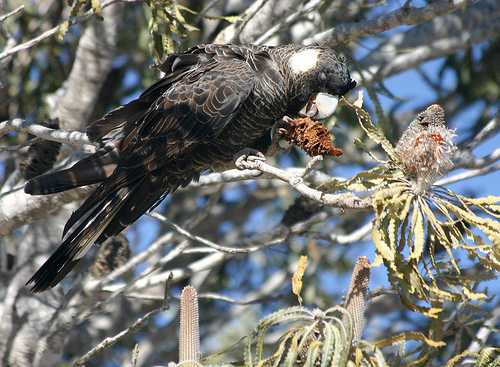Colours
Distinguishing features
It is mostly dark-grey with narrow vague light-grey scalloping, which is produced by narrow pale-grey margins at the tip of dark-grey feathers. It has a crest of short feathers on its head, and it has whitish patches of feathers that cover its ears. Its lateral tail feathers are white with black tips, and the central tail feathers are all black. The irises are dark brown and the legs are brown-grey. Its beak is longer and narrower than that of the closely related and similar Short-billed Black Cockatoo.
The adult male has a dark grey beak and pink eye-rings. The adult female has a bone coloured beak, grey eye-rings, and its ear patches are paler than that of the male.
Juveniles have a bone coloured beak, grey eye-rings, and have less white in the tail feathers. (Wikipedia)
Size
- From 50 cm to 60 cm (Length of specimen)
Wingspan
- Up to 115 cm and averaging 110 cm
Synonyms
Similar taxa
-
Animalia:
Short-billed Black Cockatoo (species: Calyptorhynchus latirostris)
The Short-billed Black Cockatoo beak is shorter and broader than that of the closely related Long-billed Black Cockatoo. (Wikipedia)
Distribution
Distribution and habitat preferences
It is endemic to south-western Australia and is closely associated with moist, heavily forested areas dominated by Marri. (Wikipedia)
Audio recordings
Same pair as XC464399 at top of dead tree in dense woods, about 20 meters above ground. Pair were recorded while initially perched and then recorded while flying off.
© Barry Edmonston
(source)
Diet
The species relies mainly on Marri seeds and flowers. It also consumes seeds from Banksia, Hakea and Dryandra species as well as Erodium botrys and Jarrah (Eucalyptus marginata). Like other black cockatoos, it also eats insect larvae.


